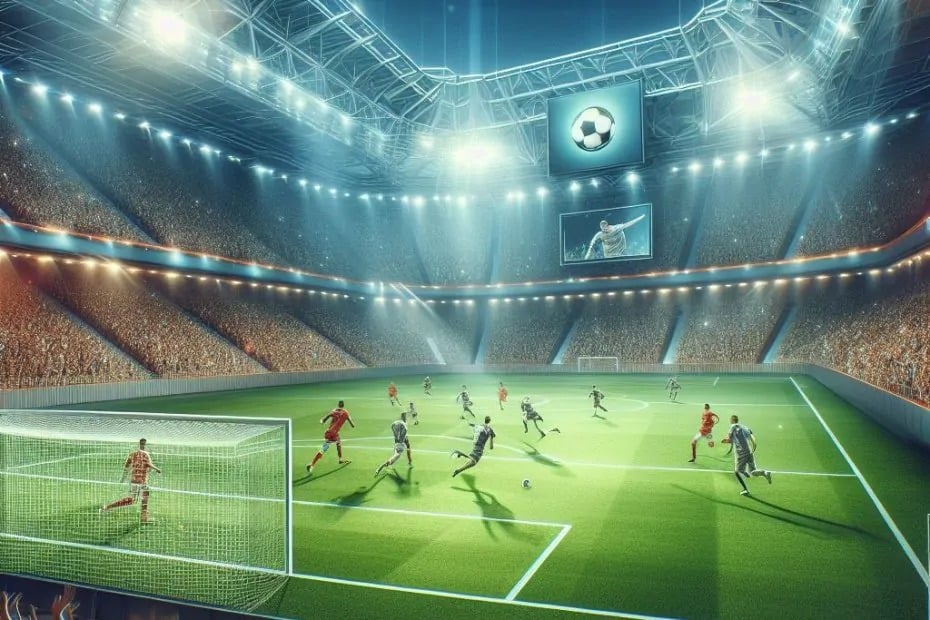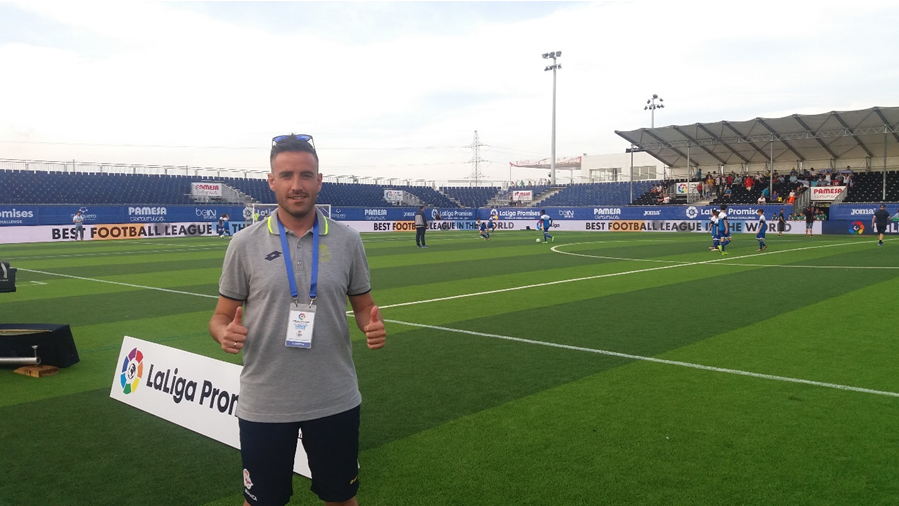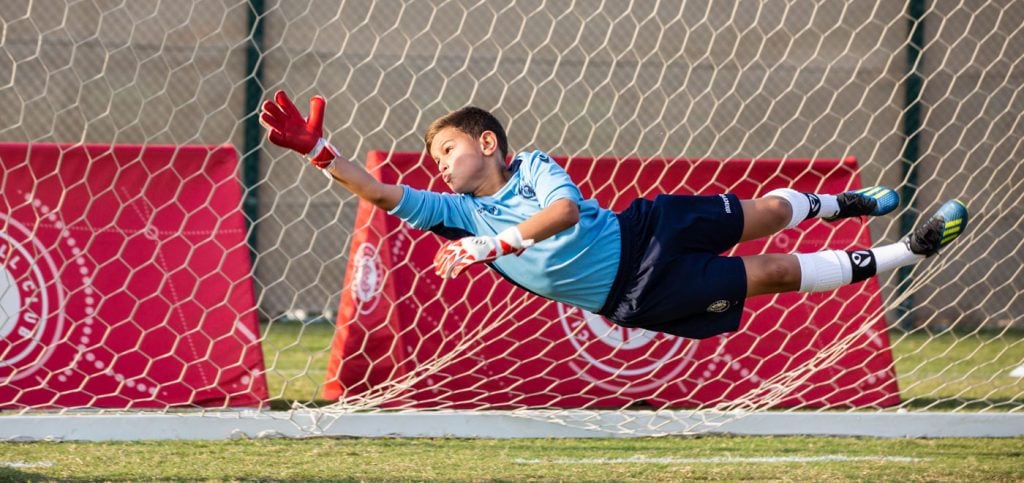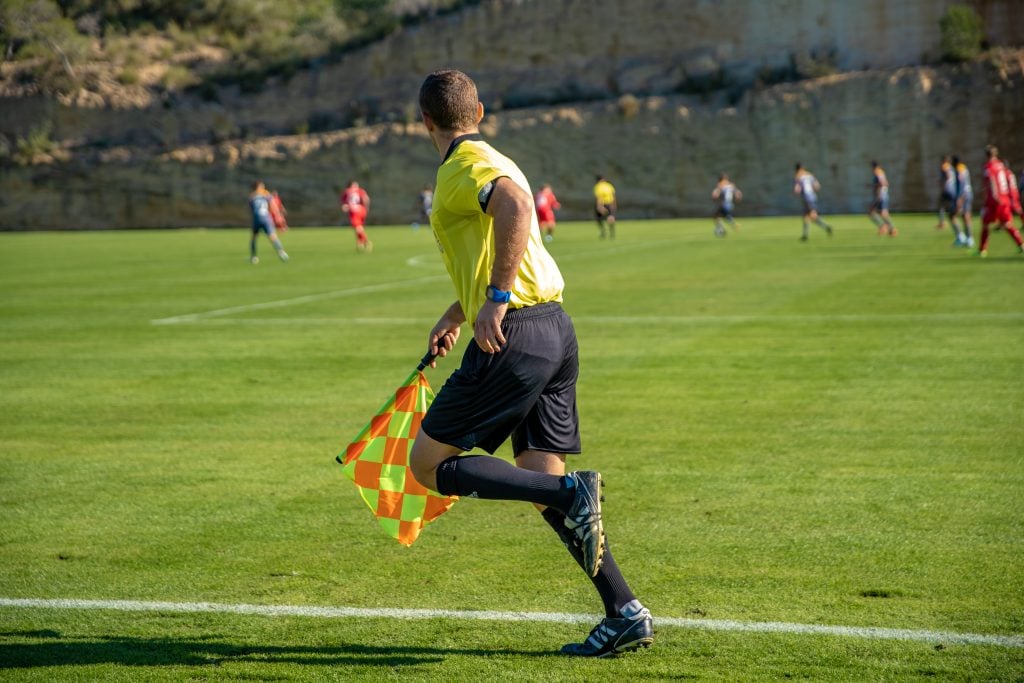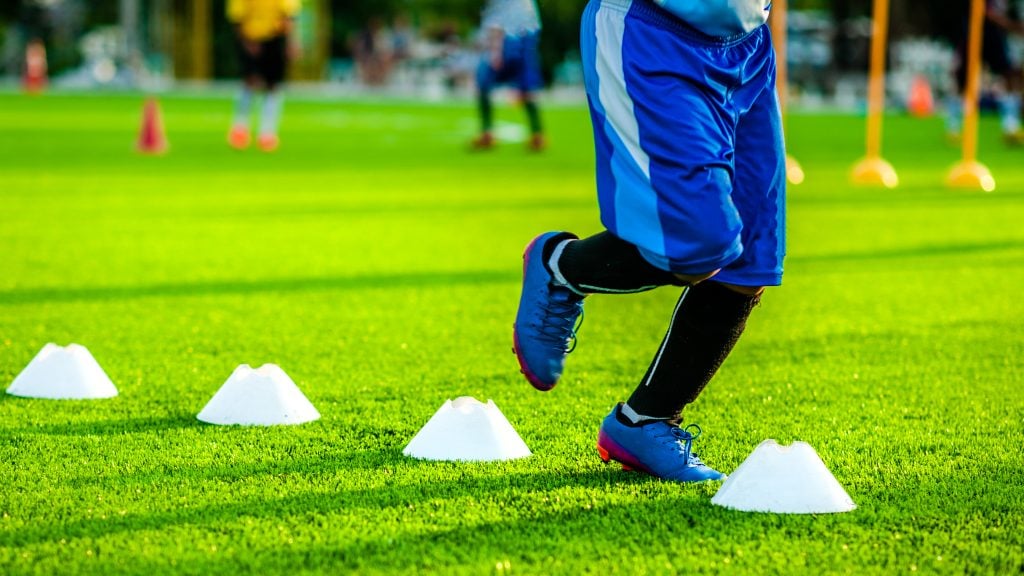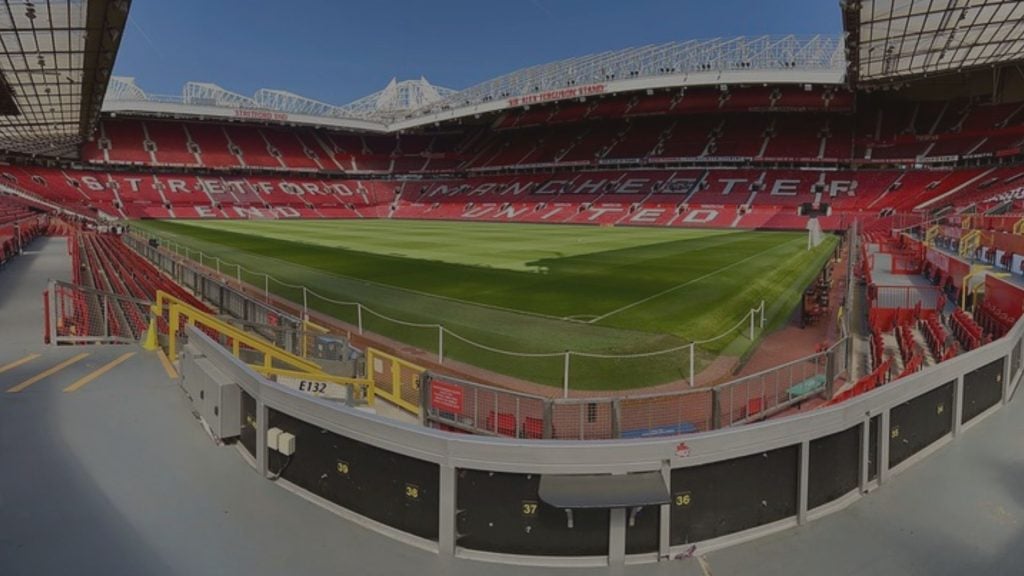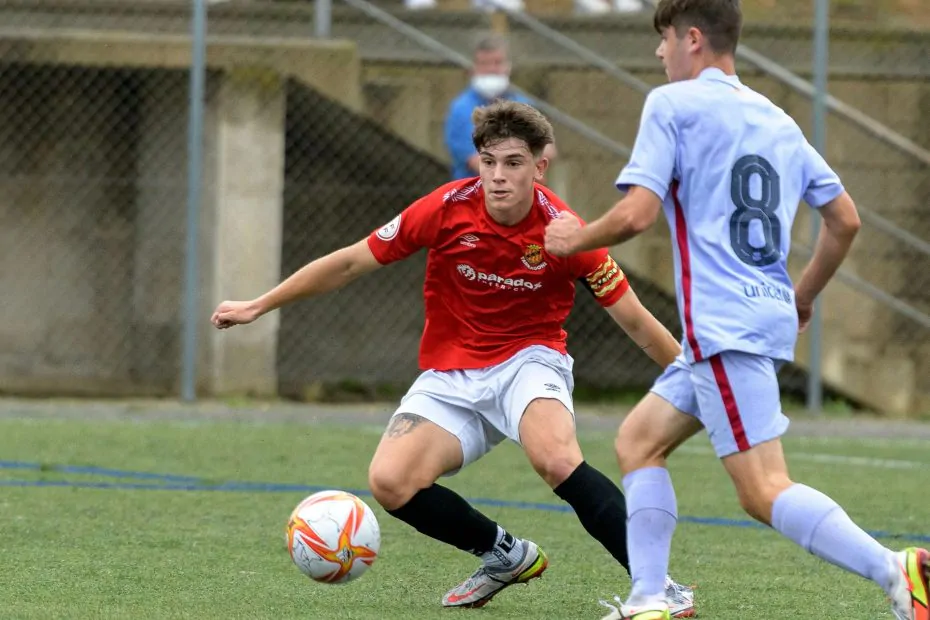Welcome to an enthralling journey through the French soccer ranks! It’s right here, in the heart of the sport that awakens passions all over the world, that the footballers of tomorrow are being molded. Get ready for an enlightening and fascinating journey through France’s soccer leagues.
If you’re interested in the different soccer levels and would like to give your child the opportunity to develop as a soccer player in a specialized environment during the summer, then we highly recommend that you explore the option of a summer soccer camp in France – a great way to cultivate your child’s talent from an early age and take them to the next level!
Get to Know the Different French Soccer Categories and Levels Classified by Age
Let’s head straight to the pitch and discover the main French soccer levels classified by age.
U6: Under 6 years of age
In the U6 children’s soccer category, these little players begin to take their first steps in the world of football. Although they don’t play any official matches, this is the best time to instill in them a love for the game and let them have fun on the pitch. Training focuses on fun activities to develop basic skills such as running, dribbling, and kicking the ball.
U7: Under 7s
At the U7 children’s soccer level, the kids start to learn essential soccer skills, such as controlling the ball, and passing it to their teammates. The focus remains on development and fun, and the games are played on a friendly basis. Basic soccer concepts are introduced, such as teamwork and the basic rules of the game.
U8: Under 8s
Players in the U8 category begin to take part in friendly matches or small tournaments, introducing a hint of competitiveness. As in the previous levels we’ve mentioned in French soccer, fun remains the golden rule. The development of basic technical and tactical skills is encouraged.
U9: Under 9s
In U9s children’s soccer, competitiveness becomes more structured, and the young soccer players begin to understand the importance of teamwork and the rules of the game. Teamwork and decision-making are also stressed.
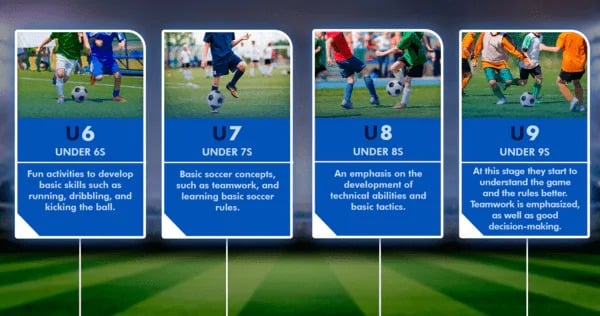
U10: Under 10s
The U10s continue to develop their technical and tactical skills and participate in more meaningful competitions, such as local tournaments. U10 boys’ soccer is more competitive but it’s still very much about developing skills and technique.
U11: Under 11s
At the French U11 soccer level, young players are ready to learn more advanced tactical concepts and compete in matches on larger pitches.
U12: Under 12s
The U12 level in French soccer is a step towards more competitive and intense matches. Players hone their technical and tactical skills at this level.
U13: Under 13s
At this stage, the U13s face more substantial challenges and their coaches emphasize an integral approach to training, both in individual and collective skills.
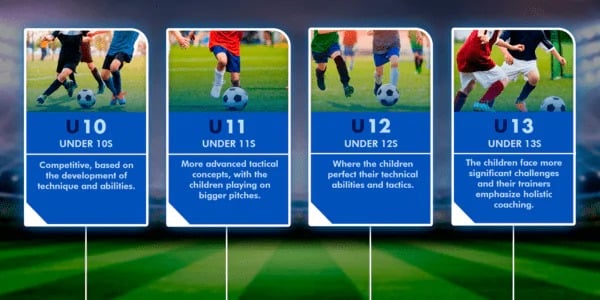
U14: Under 14s
The U14s is a key stage in the development of young players. At this age in France, teams play in more competitive leagues and tournaments.
U15: Under 15s
In the U15 category, players continue their development and prepare for larger regional and national leagues and cups.
U16: Under 16s
The U16s are on the verge of making the leap to the elite categories. Technical and tactical skills are being sharpened, and some up-and-coming talents are beginning to really shine.
U17: Under 17s
The U17 category serves as a springboard to the higher categories, and the players get ready to compete at a national and international level.
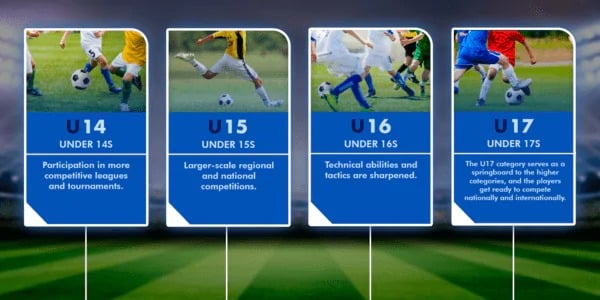
U18: Under 18s
At this stage, players are hoping to join an elite team. Competition becomes fierce, and the teams aim to develop future top players.
U19: Under 19s
The U19 category is an essential step on the road to becoming a professional player. Players face intense competition and work on their ongoing development.
U20: Under 20s
The U20s is the last stage before making the leap to the elite categories. The emphasis here is on technical, tactical, and physical skills in order to prepare young players for the world of competitive football.
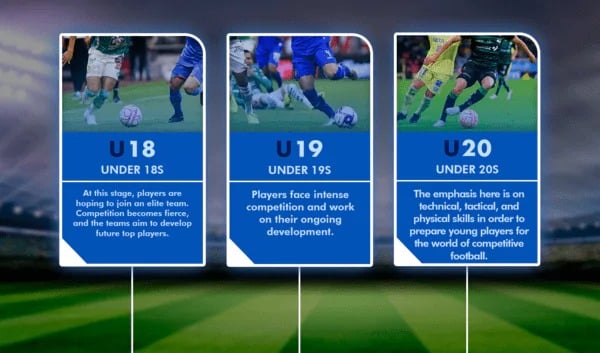
French Soccer Levels Classified By Divisions
French soccer doesn’t only divide into age groups, but also into divisions. These divisions chart each club’s course in their quest for glory. Let’s take a look at the most prominent divisions:
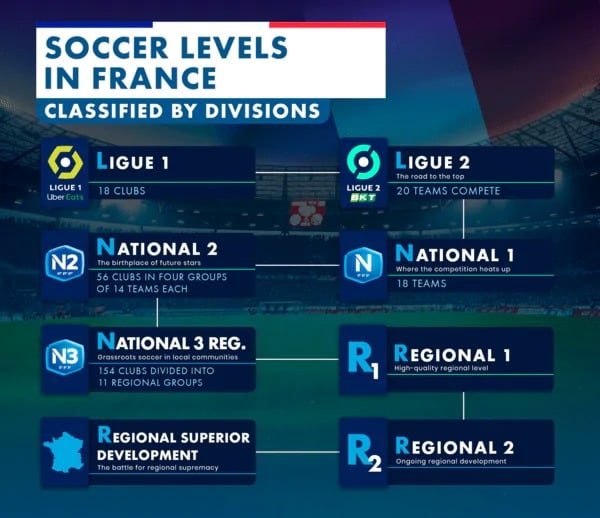
Ligue 1: The pinnacle
Ligue 1 is France’s leading professional soccer league, where the country’s top clubs compete. It’s a showcase for international talent and one of the most popular leagues in the world. Here’s a quick summary:
- An elite competition with 18 teams (from season 23/24)
- 34 matchdays in an exciting round-robin format
- The team with the most points is crowned champion
- The top two teams qualify for the UEFA Champions League
- The bottom two teams are relegated directly to Ligue 2
Ligue 2: The road to the top
Ligue 2 acts as a springboard for clubs hoping to get promoted to Ligue 1. Here you can find teams with huge potential and some very promising young players. Here´s a quick summary:
- 20 teams battle it out
- The team with the most points is proclaimed the champion
- The top two are promoted directly to Ligue 1
- The third, fourth, and fifth teams fight it out in promotion play-offs
- The bottom three teams are relegated to the Championnat National 1
National 1: Where the competition gets hot
The third division, National 1, is a very demanding league, as teams are fighting for promotion to Ligue 2 and potentially to Ligue 1:
- A highly competitive league with 18 teams
- The top three are promoted to Ligue 2
- The bottom four are relegated to Championnat National 2
National 2: The birthplace of future stars
The National 2 is the fourth French division, where young talents with impressive potential can be unearthed. Here’s how it’s structured:
- A total of 56 clubs split into four groups of 14 teams
- Open to both affiliate and non-professional clubs
- The team with the most points in each group is crowned champion
National 3- Regional: Grassroots soccer in local communities
From here on, the levels are subdivided into regions and districts, allowing for greater participation at a local and regional level. These divisions are vital to the overall growth of soccer in the local communities. They have the following structure:
- 154 clubs divided into 11 regional groups
- The winners are promoted to National 2
- Relegation varies according to the region and available places
Regional 1: High-quality regional level
Regional 1 is one of the most important regional categories, where teams compete at a local level and have the chance to move up to the higher divisions.
- It’s an important regional group
- Group champions can be promoted to National 3
- Encourages competitiveness and the growth of local soccer
Regional 2: Ongoing regional development
Regional 2 is an extension of Regional 1, where local soccer development continues to be nurtured. Every match is an ideal chance to showcase talent and passion for the game.
Regional Superior Division: The battle for regional supremacy
This high-level regional category features teams competing in their own regional areas, striving for promotion within their region. Excitement runs high in every single match!
Levels in Women’s Soccer in France
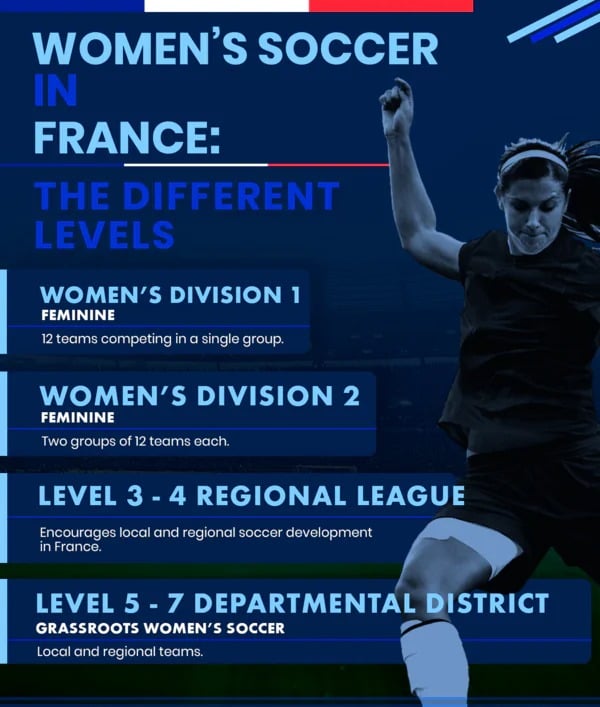
Women’s soccer in France has seen an exciting upsurge in recent years, providing players with a platform to excel and develop in this thrilling sport. Among its categories we can mention:
División 1 Féminine
Division 1 Féminine is the highest level of women’s soccer in France, featuring the country’s top teams. It features:
- 12 teams competing in a single group
- The team with the most points at the end of the season is crowned champion and qualifies for the UEFA Champions League, along with the second and third-placed teams
- The bottom three teams drop down to Division 2 Féminine
División 2 Féminine
Division 2 Féminine is the second division in French women’s soccer and creates opportunities for young players to develop. It’s characterized by:
- Two groups of 12 teams each
- Each team plays each other home and away
- The winners of each league are promoted to Division 1 Féminine
Level 3 – 4 Regional League
Regional women’s leagues encourage local and regional soccer development in France.
Level 5 – 7 Departmental District: Grassroots Women’s Soccer
Levels 5 to 7 of the Departmental District constitute an essential element of women’s soccer in France. These divisions are the backbone of the sport’s development structure. Local and regional teams compete at these levels, providing vital opportunities for up-and-coming and experienced players alike.
As they progress in these levels, this builds greater commitment and passion for the game, creating a strong talent base that will eventually lead to success at higher levels of women’s soccer in France.
The Importance of Talent Development
Talent development in soccer in France is a key factor in shaping the stars of the future. Through a solid system of different levels and divisions, young players receive the necessary grounding to nurture and develop their skills from an early age.
The lower levels play a crucial role in providing players with the chance to grow and develop in a conducive environment.
France has world-renowned clubs, such as Paris Saint-German (PSG), Olympique de Marseille and AS Monaco, all of which have created and implemented strong talent development strategies.
These clubs have produced some of the best players in the world, bearing witness to the effectiveness of their training programs. Our High Performance Soccer Camps in France provide a unique experience, where players are immersed in a professional, high-level European soccer setting.
Competitions and Tournaments at the Grassroots Level
Youth soccer in France, at a junior level, is a rich terrain for the development of future soccer stars, and it has plenty of competitions and tournaments that can play a crucial role in the training and development of young players. These competitions and tournaments are instrumental in identifying talent, improving skills, and promoting the key values of this sport.
Junior Club League:
- Championnat National U19: This league is one of the most important junior club competitions in France. Under-19 teams compete at a national level and it’s a stepping stone for those who are trying to move up to the higher levels. The elite clubs compete in this league, allowing young players to test themselves against some of the best talent in the country in their age group.
- Championnat National U17: Much like the U19 league, this category focuses on players under the age of 17. Like its counterpart, it’s an important platform for nurturing young talent and helping to identify future stars.
Regional and National Tournaments:
- Gambardella Cup: This is one of the most prestigious junior competitions in France. The competition is very exciting and has been the launch pad for many outstanding players in French soccer, including the world-renowned Kylian Mbappé. The Gambardella Cup provided Mbappé with a stage to showcase his talent and develop his skills, which later led to his rise to soccer’s elite. He is currently featured in the prestigious FourFourTwo magazine, which ranked him as one of the top 100 players of the 21st century, at a mere 24 years of age.
- Regional Tournaments: At a regional level, a number of tournaments are organized, which allow teams to showcase their talents. These tournaments are an excellent opportunity for young players to acquire experience in a more competitive scenario.
International Tournaments:
- U-20 World Cup: At an international level, the U-20 World Cup provides a platform for young French talent. This tournament witnessed the appearance of some true star players, some of whom have gone on to be promoted to the French national team and to have successful careers at elite clubs.
- Under-19 European Championship: This European championship brings together the best U-19 teams from all over the continent. French players regularly participate in this tournament, and it gives them the chance to compete at an international level and gain valuable experience.
A string of successful and now legendary footballers have emerged from the grassroots ranks in France, including greats such as Thierry Henry, Zinedine Zidane and other big names.
What Level Should My Child Start at in French Soccer?
If you are an enthusiastic parent and are wondering which level your child should start at in French soccer, then the answer really depends on his or her age and past experience. The French grassroots categories are an ideal way of introducing children to the world of soccer at an early age. As they grow and become more skilled, they can progress to more competitive levels.
In short, the French soccer system is a well-designed structure that encourages the development of young talented players and offers exciting opportunities for tomorrow’s professional soccer players.
Discover the exciting world of French football and track the stars of the future! If you’re also interested in learning about soccer systems and levels in other countries, then we’d like to invite you to take a look at this article on English Soccer Levels.
You’ll gain a fascinating insight into how different countries develop young talent in the exciting world of soccer.
Bibliography:
Federación Francesa de Fútbol (FFF). [ https://www.fff.fr/ ]. Accessed on 17th October 2023.
Ligue de Football Professionnel (LFP). [ https://www.lfp.fr/ ]. Accessed on 17th October 2023.
Federación Francesa de Fútbol (FFF) – Women’s Football Section. [https://www.fff.fr/16-le-football-feminin/index.html]. Accessed on 17th October 2023.
Mackenzie A, White M, Lea G, Pope C. Ranked: The 100 Best Players of the 21st Century. FourFourTwo. (1st March 2023). Available here: [ https://www.fourfourtwo.com/features/ranked-the-100-best-players-of-the-21st-century/4.]. Accessed on 17th October 2023.


